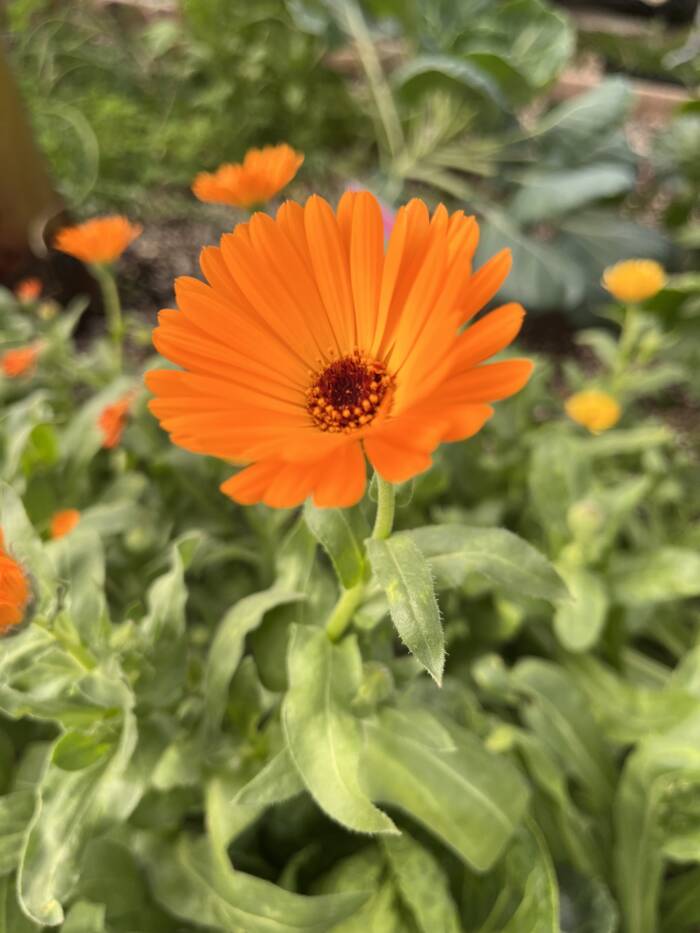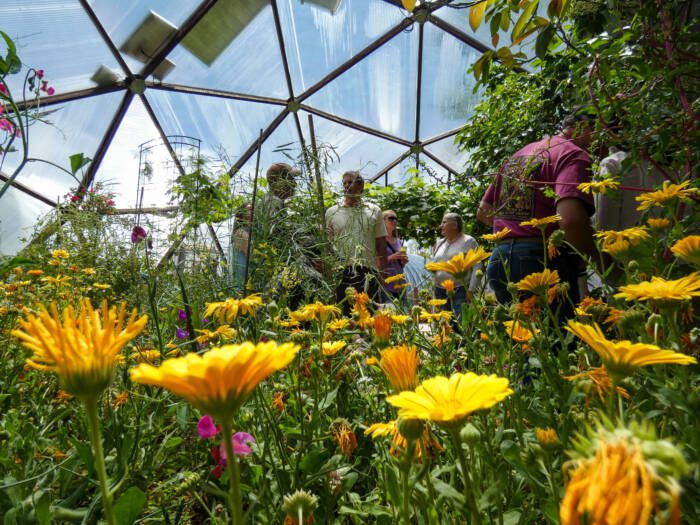
Featured Plant of the Month: Calendula!
This Sunny Flower Deserves a Prime Spot in Your Growing Dome

Calendula or Calendula officinalis is from the Asteraceae or Daisy family and is native to Southern Europe and the Eastern Mediterranean area. Early American settlers brought calendula seeds to America so they could plant them in their kitchen gardens. These gardens were typically just outside the home and narrow so they could be tended from either side. Kitchen garden beds were full of plants used for medicine, food, and seasonings. As calendula can be used for all three purposes, it was a very important plant to have in the kitchen garden.
A small, bushy plant that can grow to almost two feet tall, it thrives in cool weather but is only short-lived in warmer climates. It has light green leaves that are lance-shaped and yellowish-orange flowers similar to daisies. The flowers tend to open in sunny, dry weather and close when the weather is cold or moist.
Calendula is an annual plant unless you live in hardiness zones 9-11, where it will grow as a perennial. Calendula has been in use as a medicinal plant since around the 12th Century. This plant is high in flavonoids, which are plant-based antioxidants that protect us from free radical molecules. It is thought to fight inflammation as well as bacteria and viruses. Calendula is also used topically and in many cosmetic products.
Growing Calendula in Your Garden
Calendula is a low-maintenance plant that is a wonderful addition to any garden as it attracts pollinators as well as being useful for cooking and medicinal products. It prefers full sun but does fine with partial sun and even some shade in hotter zones.
Calendula likes rich, well-drained soil with a pH between 5.5 and 7.0. The seeds can be direct sown in your greenhouse garden beds and will self-seed, so it will most likely appear in your garden every year. To have early blooms on outside garden plants, start your seeds 6-8 weeks before the last frost. Sow seeds ¼-½” deep, and they should germinate within 5-15 days.
Moderate watering is best for calendula. To promote a bushier plant, trim your plant back; trimming your plant and picking the flowers encourages growth which will also help your plant to bloom into the fall. Calendula is also a good trap crop to lure aphids away from the fruits and vegetables in your greenhouse.
Fun Facts
- The name Calendula comes from the Latin word kalendae, which refers to the first day of the month. It’s thought this is because it was found blooming at the beginning of the month throughout most of the year.
- Did you know that calendula is used in many cosmetic products, even perfume? It is also an excellent dye used on natural fabrics.
- Calendula is also called Poet’s marigold for all the poems written about it. It is called Pot Marigold for its use in soups and stews. Another name is Mary’s Gold referring to the rays of light often painted around the Virgin Mary’s head. Despite these names calendula and marigold are two different flowers.
- Calendula isn’t mentioned specifically in any poems, but since it is in the Daisy family here’s a poem for you: “Tread Lightly, she is near Under the snow, Speak gently, she can hear The daisies grow.” – Oscar Wilde
- Did you know calendula is used as a substitute for saffron? This is why it is called “Poor man’s saffron”.
- Calendula is known as the “flower of rains” as they used to say that if the flower opened in the morning, it may rain.
- Calendula was the International Herb of the Year in 2008! 🏆
Calendula Companion Plants
As we’ve mentioned before, companion planting is using the knowledge of which plants are beneficial to each other. Whether that is because they add nutrients to the soil, invite beneficial insects to your garden, or act as trap crops, such as calendula, practicing companion planting is wise. An extra bonus is that calendula adds beauty to your dome garden like many other flowering companion plants!
Here are a few plants that you can interplant calendula with: basil, carrots, cucumbers, peas, peppers, potatoes, salad greens, squash, strawberries, and tomatoes. Visit the Farmers’ Almanac Companion Planting Guide to learn more.

How to Harvest Calendula
Calendula is best harvested in the morning before watering your greenhouse, as you want the flowers dry. Medicinally they are best harvested when half open, and the more you harvest calendula, the longer the plant and flowers will grow for you, even into the fall. Calendula flowers can be used as a salad garnish and in many recipes. It is also used as a substitute for saffron or dried and used to make teas, salves, tinctures, lotions, and other medicinal products.
There are many methods to dry calendula flowers, including using a dehydrator. You can also leave some flowers for harvesting seeds. Allow the petals to drop and the seed heads to turn brown, then store them in an airy bag to dry and then collect the seeds.
Check out our calendula lotion and bug-repellent recipes.
Do you have your own Calendula tips, tricks, or uses? Comment them below!

1 Comment
Boil and simmer 3 tbsp dried flowers in 10 0z milk for 15 min. Strain. Keep in Refrigerator and take a tbsp daily for 3 weeks. Kills fungus in body. (Hanna Kroeger gave this remedy for metastatic CA also).
I have a sister who takes this and she was able to rid herself of her heart murmur. We use flax milk.